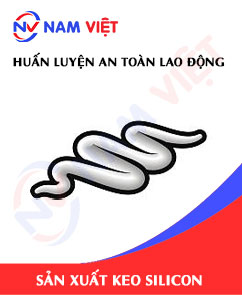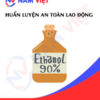Occupational Safety Training For Silicone Manufacturing
99,000 ₫
Note: The above price is calculated for one person, the price may fluctuate depending on the number of trainees participating in the course and the movement of the market. For more accurate pricing support, please refer to the quotation or contact directly with our consultants.
Occupational safety is an important issue in silicon manufacturing factories and needs to be addressed promptly to ensure the health and safety of workers, as well as to enhance the reputation of enterprises. The Occupational Safety Training course is one of the effective solutions to raise awareness about preventing occupational accidents for workers participating in silicon manufacturing.
Table of Contents
Toggle1. Overview of Silicon
a. What is Silicon?
Silicon adhesive is a special type of glue made from Silicone resin, which is a synthetic polymer with excellent elasticity, heat resistance, and waterproof properties.
Silicon adhesive is widely used in industries such as construction, electronics, automotive, aerospace, and many other applications. It is water-resistant, waterproof, has strong adhesion, withstands high temperatures, and has good elasticity, making it ideal for bonding and connecting different materials to create a strong and durable link.

b. Machinery Used in Silicon Manufacturing
Silicon manufacturing is a complex process requiring specialized equipment; therefore, manufacturing machinery is usually expensive and only used in large factories. Key equipment includes:
- Furnaces: The main equipment for heating silicon crystals to produce pure silicon.
- Molding machines: Used to shape and form silicon products.
- Silicon adhesive mixers: Used to blend the adhesive components evenly.
- Quality control equipment: Used to check product parameters such as elasticity, plasticity, and heat resistance.
- Filtration equipment: Used to remove impurities and dust during manufacturing.
- Packaging equipment: Used to package and store silicon products before delivery to customers.

c. Silicon Manufacturers in Vietnam
There are many well-known silicon adhesive brands worldwide and in Vietnam, including:
- Dow Corning: A multinational corporation producing silicon adhesives and related products, headquartered in the United States with branches worldwide.
- Momentive Performance Materials: A multinational silicon adhesive manufacturer, headquartered in the United States, with branches in many countries.
- Wacker Chemie AG: A German multinational company producing silicon-related products, including silicon adhesive.
- GE Silicones: A brand under GE Advanced Materials, producing silicon and silicon adhesive products.
- Sika: A Swiss multinational company producing construction and industrial products, including silicon adhesive.
- Sonneborn: A U.S.-based silicon adhesive manufacturer providing products for various applications.
In Vietnam, well-known silicon adhesive brands include Dow Corning, Momentive, Wacker Chemie, Hòa Bình Silicon, Silicon Vietnam, Silicon Thăng Long, etc.

d. Specific Jobs in Silicon Manufacturing Factories
Group 1
- Chief Executive Officer, Deputy CEO, and department heads in silicon manufacturing factories.
Group 2
- Safety officers: Manage safety in the factory, design safety procedures, supervise, and ensure employees follow safe working procedures.
Group 3
- Material preparation: Main materials for silicon manufacturing include silicon ore and coke. Workers transport, store, and check the quality of these materials before use.
- Silicon ore smelting: Silicon ore is heated in a furnace at high temperature to separate silicon from impurities, known as the reduction process.
- Coke processing: Coke is processed to produce reducing gas and compounds needed for silicon manufacturing.
- Silicon manufacturing: The process involves a reaction between reducing gas and silicon in high-temperature furnaces, monitored with specialized equipment.
- Refining and packaging: After manufacturing, silicon is refined to remove remaining impurities and then packaged for delivery to customers or manufacturers using silicon.
Group 4
- Office work, service, sales, and marketing.
- Manufacturing management, quality management, human resources management, materials management, financial and accounting management.
- Research and development of new products and packaging design.

2. Overview of Occupational Safety Training for Silicon Manufacturing
This article focuses on Group 3 because Group 3 directly participates in manufacturing and faces the highest occupational safety risks. Refer to other groups here.
a. What is Group 3 Occupational Safety Training?
- Group 3 Occupational Safety Training equips workers with awareness on preventing workplace accidents.
- The training helps workers recognize hazards and prevent risks, reducing the likelihood of accidents during work.
REGISTER FOR OCCUPATIONAL SAFETY TRAINING SERVICE
b. Training Duration
Initial Safety Training Duration
- Total training time is at least 24 hours, including testing time.
- 8 hours of theory on occupational safety and hygiene policies and laws
- 8 hours of theory on basic occupational safety and hygiene knowledge
- 4 hours of theory on specialized training content
- 2 hours of practical training on specialized content
- 2 hours of final theory test
The safety training center may schedule multiple sessions depending on workers’ availability. Typically, there are six sessions over three days, provided the company allows continuous training.
Periodic Safety Training Duration
- Before the occupational safety card expires, workers must complete periodic occupational safety training, with periodic training duration being at least 50% of the initial training duration.
Explanation: Total periodic training time is at least 12 hours, including testing. After completing the course and passing the test, workers will have their occupational safety card renewed.
c. Training Content
| No. | TRAINING CONTENT | TRAINING TIME (HOURS) | |||
| Total | Including | ||||
| Theory | Practice | Test | |||
| I | Occupational safety and hygiene policies and laws | 8 | 8 | 0 | 0 |
| 1 | Overview of the legal system for occupational safety and hygiene. | 6 | 6 | ||
| 2 | Standards and technical regulations for occupational safety and hygiene. | 1 | 1 | ||
| 3 | Specific regulations of government agencies regarding safety and hygiene when building, expanding, or renovating manufacturing facilities and equipment. | 1 | 1 | ||
| II | Basic occupational safety and hygiene knowledge | 8 | 8 | 0 | 0 |
| 1 | Basic knowledge of workplace hazards and risks. | 4 | 4 | ||
| 2 | Methods to improve working conditions. | 1 | 1 | ||
| 3 | Safety culture in manufacturing and business. | 1 | 1 | ||
| 4 | Rights and obligations of employers and employees; occupational safety policies; role and duties of safety officers. | 1 | 1 | ||
| 5 | Occupational safety rules, signage, use of safety equipment and personal protective equipment, first aid skills, and prevention of occupational diseases. | 1 | 1 | ||
| III | Specialized training content | 6 | 4 | 2 | 0 |
| Comprehensive knowledge of machines, equipment, hazardous substances; risk assessment and management; safe working procedures for equipment and hazardous materials. | 6 | 4 | 2 | ||
| IV | Final Occupational Safety Test | 2 | 2 | 0 | 0 |
| Total | 24 | 22 | 2 | ||
See more training content for all 6 groups
d. Occupational Safety Card
After completing the occupational safety training and passing the test, workers will receive an occupational safety card (commonly called Group 3 safety certificate).
The Group 3 safety card includes personal information such as name, date of birth, job, and specific work environment, as well as training duration, red stamp, and signature confirming course completion.
According to Clause 2 of Article 24 of Decree 44/2016/ND-CP, there are two cases:
- If the employer and employee have a labor contract, the employer must sign, stamp, and validate the safety card for the worker in Group 3 after completing the training and passing the test.
- If the worker is freelance or seasonal without a labor contract, the training unit must sign, stamp, and validate the safety card after the worker completes the training and passes the test.

3. Identifying hazards affecting workers during silicon manufacturing
During silicon manufacturing, there are several risks affecting workers’ health, including:
- Risk of burns: During silicon manufacturing, equipment needs to be heated to create products. Therefore, the risk of burns is very high if workers do not wear sufficient protective equipment such as gloves, safety shoes, and protective clothing.
- Risk of dust exposure: Silicon manufacturing can generate dust and small particles, causing respiratory issues for workers. To minimize this risk, factories must have ventilation systems, and workers should wear masks to reduce inhalation of dust.
- Risk of occupational accidents: The equipment and machinery used in silicon manufacturing can cause accidents if not operated correctly. Therefore, factories need to train workers on safe equipment and machinery use.
- Electrical hazards: If electrical equipment in the factory is not regularly maintained, not properly insulated, or not waterproofed, it can pose a risk of electric shock to workers during manufacturing.
- Risk of chemical exposure: Some chemicals, such as acids, are used in silicon manufacturing and can be harmful if not used properly. Therefore, workers must be trained on chemical handling and wear sufficient protective equipment to safeguard their health.
- Risk from temperature and voltage: Silicon manufacturing may involve high heat and electricity, posing risks to workers. Factories must ensure workers are trained in safe equipment use and provided with full protective gear.

4. Common occupational accidents for workers during silicon manufacturing
Silicon manufacturing may present several hazards for workers, including:
- Exposure to hazardous chemicals: Workers may come into contact with chemicals such as silicon, hydrochloric acid, phosphorus, and organic solvents, which are harmful at high concentrations or prolonged exposure.
- Fire and explosion accidents: Silicon manufacturing often uses flammable chemicals such as methane, hydrogen, and acetylene. Without proper safety measures, these can cause fires and explosions, threatening workers’ lives and property.
- Mechanical accidents: These often occur when operating machinery, cutting, drilling, welding, or transporting materials, potentially causing harm to workers’ health, property, or lives.
- Noise and vibration: Silicon manufacturing often produces high noise and vibrations, which can affect hearing, eye health, and cardiovascular health.

5. Safety measures when participating in silicon manufacturing
To ensure worker safety during silicon manufacturing, the following measures should be implemented:
- Use full protective equipment: Workers must wear helmets, safety goggles, gloves, protective coats, and non-slip shoes.
- Use toxic gas detection equipment: Silicon manufacturing factories must have toxic gas detection systems to ensure a safe working environment.
- Ensure machinery safety during operation: Workers must be trained on using equipment and machinery safely to avoid accidents.
- Use safe cleaning agents and chemicals: Chemicals used in silicon manufacturing must be safe and comply with handling and storage regulations.
- Perform regular inspections: Manufacturing equipment must be checked regularly to ensure safety and prevent unwanted incidents.
- Ensure workplace hygiene: Silicon manufacturing must maintain a clean and ventilated environment to protect workers’ health and safety.
- Labor safety training: Silicon manufacturing factories must train workers on occupational hazards, proper use of protective equipment, and accident prevention measures.
- Regularly conduct workplace environmental monitoring in the factory, collecting and analyzing harmful factors to reduce hazards and prevent occupational diseases for workers.
6. Benefits of labor safety training for silicon manufacturing
An Toan Nam Viet provides excellent benefits to businesses upon completing labor safety training courses in accordance with Decree 44/2016/ND – CP regarding occupational safety and hygiene for companies and factories.
- Workers can identify potential hazards and take preventive measures to avoid accidents.
- Businesses can establish risk prevention measures in manufacturing, operations, and maintenance processes.
- Reduce costs associated with occupational hazards.
- Uninterrupted manufacturing increases labor productivity and product quality.
- Compliance with labor safety laws reduces legal risks.
- Enhances professionalism and company reputation, elevating the brand.
An Toan Nam Viet training courses are a solution to protect individuals from external hazards that may lead to injury or, in severe cases, death.
REGISTER FOR LABOR SAFETY TRAINING SERVICE
7. Customer feedback after completing labor safety training for silicon manufacturing
An Toan Nam Viet has years of experience supporting businesses across Vietnam, particularly in the southern provinces. This responsibility is highly valued, which is why our labor safety training is increasingly professional. Our growth is driven by positive feedback and suggestions from our clients. Below are some responses from our partners.
See more customer interviews after using the service from An Toan Nam Viet
8. An Toan Nam Viet labor safety training capability
An Toan Nam Viet is a reputable and high-quality labor safety training center in Vietnam. Safety training sessions are continuously held at factories, workshops, and construction sites across all 63 provinces.
REGISTER FOR LABOR SAFETY TRAINING SERVICE
Labor safety training license
- An Toan Nam Viet has been inspected and certified by the Department of Safety under the Ministry of Labor – Invalids and Social Affairs, confirming our eligibility to conduct labor safety and hygiene training. This strengthens our capacity in labor safety training.

Documents and lectures
- Before training materials are used in labor safety training courses, they are reviewed and verified to ensure accurate knowledge and effective application.
- Lecturers’ teaching methods are standardized according to An Toan Nam Viet guidelines, developed by experts in occupational safety and hygiene training to maximize knowledge absorption for trainees.
Facilities
- Controlling classroom factors affecting training increases teaching efficiency and trainee knowledge retention.
- Our training facilities provide spacious classrooms with standards in area, lighting, and training equipment.
9. Nationwide reputable labor safety training center
At An Toan Nam Viet, we prioritize professional labor safety training. Teaching workers to protect themselves is our contribution to the country’s development.
We meticulously prepare every detail for effective training, including tools, equipment, curriculum, materials, audio, and lighting.
Our labor safety lecturers are experienced experts, some with research on identifying hazards in all industries and prevention methods.
Lectures are practical, clear, and engaging, helping workers absorb knowledge comfortably, fully aligned with Decree 44/2016/ND-CP.
This equips workers with hazard prevention and self-protection measures, applicable in real work situations.
Our training center proudly provides professional labor safety training with advantages:
- Competitive training cost while ensuring quality.
- Flexible training schedule according to company manufacturing needs.
- Quick certification process compliant with legal regulations.
- Experienced lecturers with many years in the field.
- Controlled classroom environment to enhance teaching efficiency and knowledge retention.
- Lectures tailored to labor safety practices in businesses.
- Dedicated, professional service to support clients quickly and accurately.

10. Additional references for labor safety training in silicon manufacturing
- Labor safety training materials
- Labor safety materials for silicon adhesive manufacturing
- Labor safety training tests
- Labor safety training curriculum for silicon adhesive manufacturing
1 review for Occupational Safety Training For Silicone Manufacturing
No comments yet















namchinh.haiphong341
Dịch vụ huấn luyện an toàn lao động rất tốt nhé, giảng viên dạy rất sinh động dễ hiểu!